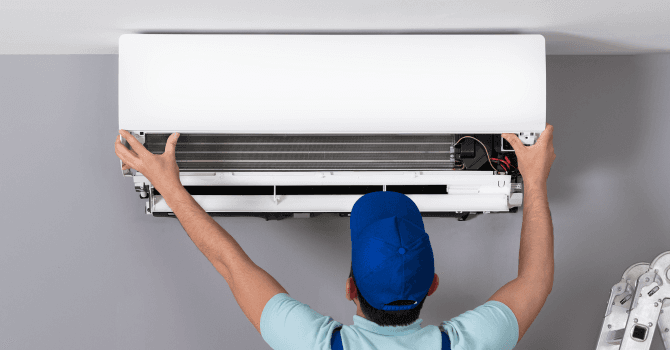10 Telltale Signs Your Foundation Needs Repairing
By Editorial Team
Updated on July 23, 2024

Renovations often focus on the surface; the glitz and glam-based concerns in the creation of your dream home. However, the foundation is the most important aspect of any structure and could be considered the bones of the home. With this in mind, proper foundation upkeep is necessary, as issues can become more costly the longer they're left as is, and also decrease the value of your home.
Referred to as "settling," our foundation can shift and break due to insufficient support as well as lack of maintenance. Some homeowners may not recognize when there are serious issues at play, but RenoQuotes.com is here to offer some informative signs that may point to potential foundational problems.
Here Are 10 Telltale Signs Your Foundation Needs Repairing
1- Visible cracks in the foundation

Source: Canva
It is only natural for homes to settle into the land around them over time. However, an excessive amount of "settling" will manifest in your home's walls as cracks, pointing to serious internal issues with your home foundation. Cracks in the exterior or interior of your home found in the form of hairline fractures, ruptures, gaps, crumbling, flaking or a collection of moisture in an area could point to a support issue.
Look for visible stair-step cracks on brick walls as well as vertical cracks which seem to be getting wider or may be leaking water, as these are indicators of wall rotation which may point to developing issues with your foundation. if you come across these signs, it may be worthwhile to have it inspected by a professional. Make sure to carefully inspect corners, joints, and mouldings; all of which should be upright and without cracks.
2- Exposed grade beam cracks
If you find cracks in the exposed concrete grade beams of your home, this is a very definite warning sign for foundational issues. Check the exposed concrete at the base of your home for cracks, making sure to look carefully for any type of abrasion. If the cracks are small, they are potentially nonstructural, but could also be the first indication of trouble.
3- Uneven floors
As stated, the foundation supports the home, and even though it is the bottom level, issues can show all the way up to the top floor. If you are noticing that the upper floors of your home are uneven or slanted, this could be a sign of foundational damage. Look for warped ceilings, drooping floors and gaps between interior walls and their adjacent floor/ceiling.
Using a level to verify, place it in random locations around the suspected surface and view the results. Don't have a level? the same method can be completed using a tennis ball. Put it in various spots and see if it moves, if it rolls to the left or right, you could very well have an issue in sight.
4- Water damage

Source: Canva
Improper water drainage is one of the main causes of foundational damage. If the soil surrounding your home has room to expand during wet spells and contract during dry spells, the soil will shift unnaturally and therefore, so will your home. This shift puts insurmountable pressure on the foundation. Also, if the water around your home is refusing to drain correctly, there could already be existing issues with the foundation. Cracks in the foundation direct water to lower soil levels, resulting in an excessive buildup of moisture around your home.
Whether water damage is a cause or symptom of foundational problems, prompt repairs are paramount. Checking for potential signs is straightforward; take a quick walk around the premises of your home. Search for hints of unnaturally wet or unnaturally dry soil, particularly after rainfall. There can also be signs hidden from plain sight, potentially behind a wall or underneath a floor. If you're concerned, it is important to take the necessary steps and make sure you're standing on solid ground.
5- Leaks or cracks around the fireplace
One of the signs of needing to repair your foundation is cracks or bowing walls around the fireplace. If you notice your fireplace cracking or moving away from the wall it is attached to, do not ignore it! Bowing walls will be immediately evident, as they will curve unnaturally, either inwards or outwards. A cracked or shifting chimney can help you uncover other foundational problems, helping you save money in the long run!
6- Sticking or swinging doors and windows

Source: Canva
The doors and windows of your home should fit snuggly in place, and shouldn't appear too loose or too tight, but should fit just right! If your house is dipping to one side due to foundational issues, you'll find it difficult to open your doors and windows; they'll stick slightly or swing open far too easily. Further, if your foundation is damaged and this is causing your doors and windows to remain slightly ajar, you may end up with uncontrolled heat loss and as a result, high utility bills.
If you are conducting an inspection of your doors and windows, make sure to include the garage or attic doors and windows as well as all vents within the home. It is good to scan for signs on a semi-regular basis, making certain that nothing has been overlooked.
7- Nails popping
If you are finding that the nails in your walls are trying to pull away and pop out, specifically popping out of sheetrock, gypsum board, as well as corner frames, then this could be evidence of deeper issues. Exposed nailheads as well as paint chipping or lifting from the walls can be considered a warning sign for foundational problems.
However, the movement of the nails could also be due to a change in humidity, depending on the climate both inside and outside of your home. This issue is commonly attributed to shrinkage stresses of the wood framing, but if you are concerned, make sure to get a professional opinion.
8- Curling or peeling wallpaper

Source: Canva
If there is a foundation issue, the walls of your home will shift and when the walls shift, the wallpaper moves along with it. When a movement of the structure of your home occurs, you will notice the wallpaper attempting to separate from its place or, it will rip. Look to the corners of your rooms to see if your wallpaper is curling away from the wall, also inspect any form of ripping wallpaper, as this could be a telltale sign that your foundation is in dire need of renovation!
9- Leaning chimney
If your home has a chimney and it looks like the leaning tower of Pisa, then you have something to be concerned about. A leaning chimney is a serious problem and points directly to structural issues with your home's foundation. A leaning chimney is an indicator of a lack of support on the chimney's structure and a need for it to be stabilized and straightened!
10- Gaps
Gaps that begin to appear in spaces where they weren't present beforehand are a hint at structural issues and a settling foundation. Look for spaces between outdoor the patio, the stairs and the home, and if there is uneven elevation around the patio. Inside the home, look at kitchen cupboards, checking for elongated spaces between the cupboards and the ceiling. When your foundation needs repairing, attachments and appliances begin to move and separate from the central structure, so this is a fail-safe sign that an issue may arise!
Author: Amanda Harvey
Get 3 renovation quotes for your foundation renovation project
RenoQuotes.com can help you get quotes for your foundation renovation. We have a network of home renovation specialists who will be glad to find the proper solution for your particular situation.
Dial 1-844 828-1588 to speak with one of our customer service representatives
Looking for something else?
Related articles
The latest industry news, interviews, technologies, and resources.

Cynthia Pigeon
•03 Nov 2025
Are you looking to add hardwood floors in the common areas of your house hoping to create a rustic feel? Cherry wood flooring, although not the cheapest option, has an exotic essence and makes for a durable choice due to its sustainable material.

Paul Riopel
•26 Jun 2025
So, you're considering getting an in-ground pool? That's a refreshing idea that is sure to delight the entire family for years to come!

Editorial Team
•25 Jul 2025
If you have a concrete floor that needs a new finish or you’re wanting to change the look of your floors and looking for an alternative to hardwood or ceramic, floor resurfacing could be of interest to you.

Editorial Team
•29 Mar 2024
Is your heat pump’s air conditioning function not working? It might not be that difficult to fix. Whether it be a faulty fan or a leaky heat pump, we’re delving into all these malfunctions, and sharing some DIY fixes on the unit itself when possible.

Editorial Team
•11 Nov 2024
Although wood as a material is very durable, it still requires tender love and care to maintain its condition. For this reason, if you have a large amount of wood in your home, it would be important for you to understand how to care for it. More specifically, if the structural elements of your home are made from wood, then it will need regular upkeep in order to stay in shape.